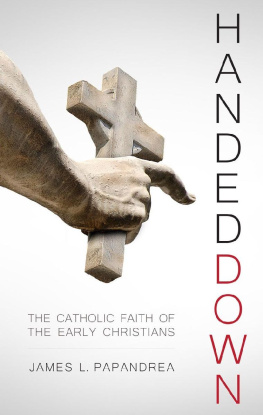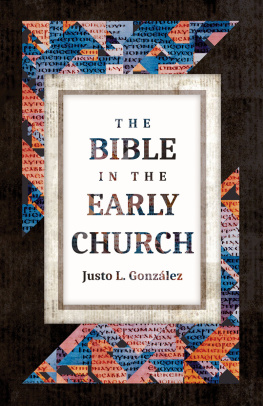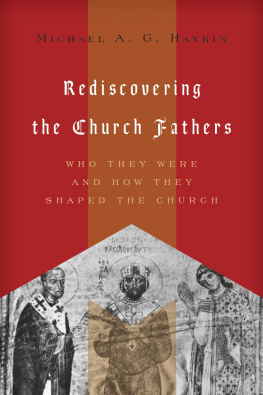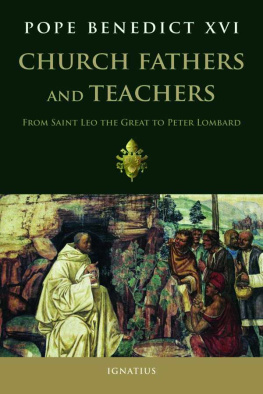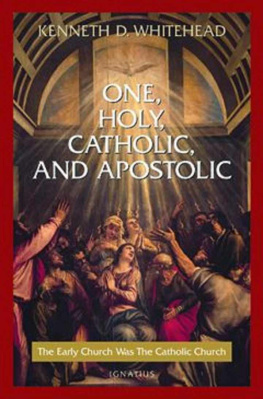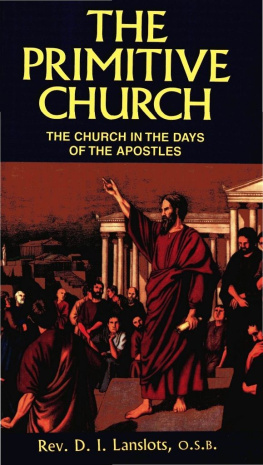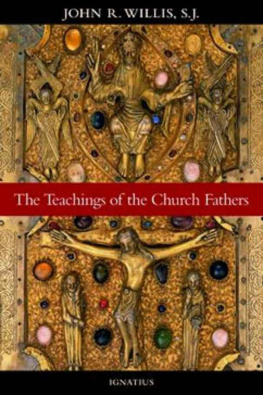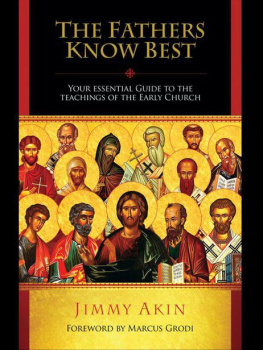Reading the Early Church Fathers
From the Didache to Nicaea
James L. Papandrea
Paulist Press
New York / Mahwah, NJ

Note to the Reader: For a list of the primary sources Internet links, select the Online Resources tab at www.paulistpress.com and then select the books title, Reading the Early Church Fathers.
The scripture quotations contained herein are from the New Revised Standard Version: Catholic Edition Copyright 1989 and 1993, by the Division of Christian Education of the National Council of the Churches of Christ in the United States of America or are from the authors own translation. Used by permission. All rights reserved.
Cover Image: Chrysostom and Athanasius, Ridley Hall Chapel, Cambridge, from a photograph by Stephen Day.
Cover design by Cynthia Dunne, www.bluefarmdesign.com
Book design by Lynn Else
Copyright 2012 by James L. Papandrea, www.JimPapandrea.com
All rights reserved. No part of this book may be reproduced or transmitted in any form or by any means, electronic or mechanical, including photocopying, recording, or by any information storage and retrieval system without permission in writing from the Publisher.
Library of Congress Cataloging-in-Publication Data
Papandrea, James Leonard.
Reading the early church fathers : from the Didache to Nicaea / James L. Papandrea.
p. cm.
Includes bibliographical references and index.
ISBN 978-1-61643-091-7
1. Fathers of the church. 2. Christian literature, EarlyHistory and criticism. I. Title.
BR67.P365 2011
270dc23
2011036793
Published by Paulist Press
997 Macarthur Boulevard
Mahwah, New Jersey 07430
www.paulistpress.com
Contents
For Susie, my soul mate, who brings out the best in me
What kind of yoke is that of two believers,
of one hope, one desire, one discipline, one and the same service?
Both are equal in the Church of God,
equal at the banquet of God.
Between the two echo psalms and hymns,
and they mutually challenge each other
which shall better chant to their Lord.
When Christ sees and hears such things, he rejoices.
To these he sends his own peace.
Where these two are, he is there himself.
Tertullian, To His Wife
I would like to thank those who went before me in the study of early Christianity; although the reader may notice that the endnotes for this volume emphasize the primary sources (and this is intentional, since I believe the primary sources are the place to begin), nevertheless I recognize that I stand on the shoulders of my predecessors in the field. I especially want to thank those who taught me to love the early Church and to appreciate the importance of historical theology: my professors at Fuller Theological Seminary, including James E. Bradley, Marianne Meye Thompson, Ralph Martin, and Colin Brown; my dissertation advisors, Dennis E. Groh and Robert Jewett, and Northwestern professors James Packer and John Wright; my students, including the Holy Family Bible Journey group and the students at Garrett-Evangelical Theological Seminary. Last but far from least, I want to thank those colleagues, friends, and conversation partners who have always supported me, encouraged me, challenged me, debated with me, and taught me so much about the grace of God, including Rich and Karin Vetrano, George Kalantzis, Stephanie Perdew VanSlyke, Glenn Murray, Paul Jarzembowski, Graziano Marcheschi, and my bandmates in Remember Rome. Getting to this point would not have been possible without each of you, and I have valued our conversations immeasurably. Finally, to my friends at Paulist Press, thank you for your confidence in me and in this project. May God bless those who read it, and may it draw them closer to God through Christ, in the spirit of James 4:8, Draw near to God, and he will draw near to you.
The period of the Church fathers (usually defined as the first five centuries of the Christian era) is known as the patristic period. Therefore, the study of patristics refers to the study of the history and theology of the early Christian Church. We will begin our study with the subapostolic age, which, as the name suggests, begins where the apostolic age ends, with the leadership of those whom the apostles had chosen to succeed them. However, we can already see the second generation of Church leaders in the pages of the New Testament, in people like Mark, Luke, Timothy, and John the Elder, to name just a few. Therefore, the subapostolic age overlaps somewhat with the New Testament, and in fact there is no well-defined line of division between the age of the apostles and the next phase of Church history. At the very least, we have to acknowledge that some apostles lived longer than others; thus, the second generation of leadership begins earlier in some places than in others.
Therefore, our exploration begins in the late first century, and though we will not focus on any of the documents that would come to be included in the New Testament, a few of the documents we will examine were written before the latest of the New Testament writings. One must keep in mind that the New Testament as we know it was not yet a standardized collection in the second century, and while the formation of the New Testament canon is a subject for a later chapter, we will begin to ask the question why some of the earliest Christian writings were not included in the Christian Bible.
The subapostolic age encompasses two phases of the history of the Church. The first phase is often referred to as the age of the apostolic fathers. The second is the age of the apologists. Each will be explained as we come to it. For now, however, it is important to note that just as there is overlap between the apostolic (New Testament) age and the subapostolic age, there is also an overlap and no clear dividing line between the time of the apostolic fathers and the apologists within the subapostolic age. Therefore we will not concern ourselves with attempting to define these stages of Church history by a strict time frame. In general, chapters 2 through 4 will cover about a century, from the last decades of the first century to the last decades of the second century, or about 80 CE to 180 CE. This date is a turning point because the first true theologians emerge at the end of the second century, beginning a new era in the history of the Church. After that, the next four chapters will examine the Church up to the early fourth century, leading to the Council of Nicaea in 325 CE. This time is taken as a watershed in Christian history, for reasons that will become evident below. The final chapter will look at the major themes that emerge from the early Church and track their trajectories in the fourth and fifth centuries and beyond.
Before we can examine the various writers and documents of the subapostolic age, we need to pause for a moment to address the differences between the writings of the early Church and modern literature. It is tempting to read early Christian documents as though they always give us just the facts; often, however, the authors are presenting more of a wish list than a news report. We must keep in mind that most of the early Christian writers were not consciously writing history for our benefit today; they were writing for the people of their own time, to convince them of something. Therefore, the following caveats will be helpful to keep in mind while reading the patristic documents.
Dont assume uniformity across the Roman Empire, or uniformity of development.
Just because a certain document includes evidence of a particular belief or practice, one cannot generalize that belief or practice as if it were universally held by the whole Church. As long as the Church was not legally recognized, communication was limited between cities and especially between the eastern and western halves of the Roman Empire. Even where communication was easy, Christians in different areas did not necessarily agree. Proof of this is in the New Testament itself, where many of the earliest Christian documents (the letters of Paul) would not exist if it were not for conflict and disagreement. Therefore, one must take the origin of a document into consideration when one is trying to determine what the Church believed and practiced. In reality, the old impression of the early Church (based on Acts 2:44), that it was characterized by a uniformity that was eventually lost and never regained, is probably far from the truth. In fact, as it happened, it was most likely quite the opposite. There was certainly a significant amount of diversity within the early Church that over time went through a kind of standardization as the boundaries of acceptable belief and practice were drawn.
Next page

